The England of tradition
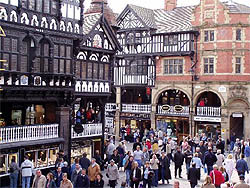 Half-timbered buildings in Chester, showing part of the Rows
Half-timbered buildings in Chester, showing part of the Rows There is a familiar tourist representation of England, and Manchester does not belong to it. London landmarks aside, Tourist England is a place of green fields, winding lanes, village cricket, stone churches, cottages (thatched, for preference) and unchanging traditions. Manchester is a buzz of brick and glass and roads and busy people: the world first noticed Manchester as a centre of change, and it is never quite the same place twice.
Yet it is easy to reach the open country outside Manchester, and the smaller, picturesque towns beyond – and, indeed, many urban dwellers choose to spend their leisure time walking in the hills, touring historic houses, or soaking up the atmosphere of country pubs. If Tourist England is not quite a reality, it is something more than a myth: its chief consumers are the English, and the income it generates has a real enough role in the rural English economy. Diligent scholars, then, should feel no shame in exploring some of the more tourist-friendly elements of the region.
Ancient cities
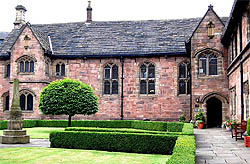 The fifteenth-century hall of Chetham's
The fifteenth-century hall of Chetham's Above all, and in spite of its Roman roots, Manchester is not as old as the England of tradition. ‘Old’ Manchester is largely Victorian: almost all that was older fell victim to frenetic urban-industrial development, wartime bombers, or peacetime planners. In the city centre, Chetham’s is truly medieval, a remarkable survival; nearby, the Cathedral is the ancient Collegiate Church, though greatly modified; and the Old Wellington and Sinclair’s pubs are centuries old in their fabric – but were transplanted to their present location in 1999. A sense of the genteel Georgian Manchester survives around St John Street, and, with the aid of a little imagination, around King Street too. And that’s about it.
For cityscapes showing the imprint of earlier ages, the two most popular destinations in Northern England are Chester, 55 kilometres to the southwest, and York, 90km to the northeast of Manchester. Both are reached by convenient transport links, as has been the case for almost two millennia: Manchester evolved from a first-century defensive position along the road connecting what were once the crucial fortress settlements of Deva Victrix and Eboracum.
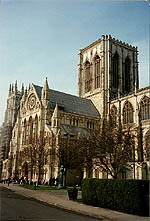 York Minster
York Minster Both Chester and York were prosperous merchant cities in medieval and early-modern times, and reflect their heritage in their streetscapes, civic buildings, and perimeter walls. Both cities, inevitably, are nowadays leisure-driven: the picturesque streets are lined with pleasant (if often crowded) boutique shops, and the nightlife is warm and noisy. Chester’s attractions include a medieval Castle, the most complete surviving city walls in Britain, and the unique Rows – timbered galleries which create an upper tier of shopping streets. York boasts an enormous Gothic cathedral or Minster, the Castle Museum, the populist Jorvik Viking Centre attraction, and exceptional streetscape survivals such as the Shambles.
Towns and villages
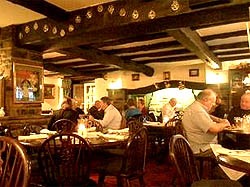
Heading out of the city into Cheshire (to the south) or Lancashire (to the north), the traveller will sooner or later reach something not too dissimilar to the mythic England of tradition. The country pubs are real enough, and so too are the stone churches. This is farming country, dotted with villages and market towns: some maintain populations of city commuters, of varying degrees of prosperity, while others remain very much the territory of “genuine locals.” Some, despite the chocolate-box cliché, really are beautiful, while others are at least beautifully preserved. It is far better to stumble upon them by accident than to treat them as destinations, but the visitor guides to Cheshire towns and Lancashire destinations may be useful.
The National Parks
By international standards, there is no wilderness in England. There are, however, regions of particular natural beauty and environmental value which, as National Parks, are carefully managed and protected from conventional development. Though the focus is on conserving natural features, plant and animal life, the Parks contain towns and villages, often of historic character, and are popular leisure destinations.
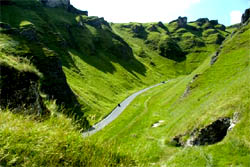
The Peak District is conveniently just beyond the south-eastern fringes of urban Manchester. The peaks in question are hilly, rather than mountainous, comprising the southern end of the Pennine range. The area is of profound geological interest, with caverns, rare minerals, and underground springs. The main town of Buxton (enclosed by the National Park region, though not part of it) was a Roman spa town, which, like Bath in Southern England, underwent a fashionable revival in the late eighteenth and nineteenth centuries.
The Lake District, close enough for a day trip, is England’s largest National Park, indelibly associated with the Lake Poets and with popular definitions of the picturesque. While the beauty of the towns and villages fringing the Lakes has encouraged an almost sedentary breed of tourism, the region is at the same time the most mountainous in England, and much loved by serious hikers and outdoor sports enthusiasts.
The North York Moors, a little closer than the Lakes, are also popular with walkers. The region is lightly populated, with many historic buildings, and again has an interesting geology.
Stately homes and historic country houses
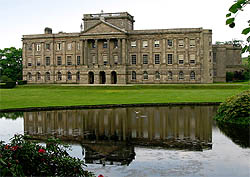 Lyme Park
Lyme Park The international success of the historical soap opera Downton Abbey confirms the world’s ongoing love affair with the “stately homes of England”, those surviving physical manifestations of a vanished and increasingly exotic social order. Sensible historians, of course, are wary of rosy mythologies, but the great country houses are at one level firmly authentic: they are spectacular now because they were built to be so, at a time when spectacle and curiosity were indicators of status and devices for gaining it.
It took the death of the underlying cultures to secure the country house as a familiar public phenomenon. The social and financial changes of the twentieth century left many of the traditional owners unable to maintain the upkeep of their houses and estates; the exceptions, some of whom are still resident, mostly depend on opening up some or all of the property for visits or social functions. Most houses, however, and particularly those on a smaller scale, are uninhabited, and lived purely through their visitors. Some are managed commercially, others by local government or by the National Trust, whose approach focuses on conservation.
The range of visitor experiences is therefore very wide. Most sites showcase historic interior furnishings or collections; others are left bare to reveal the construction of the property; some are arranged to present the relationship between the house and the farm estate which served it. Of the more elaborate sites, some show the influence of the “living history” approach, with costumed interpreters, while some, following an ancestral theme, simply aim to offer as many diverse spectacles as possible.
The area around Manchester is home to numerous historic houses, great and small, reflecting ever-changing notions of domestic management and architecture (and, indeed, architectural history: many centuries-old designs are interpretations of even older archetypes). Cheshire has a particularly rich country-house heritage, and is famous for original examples of the black-and-white “half-timbered” (timber-framed) style. Even in industrial south Lancashire, however, where urban growth has entirely erased the pattern of the old land estates, the modern streetscapes occasionally give way to an ancient survival.
In Greater Manchester
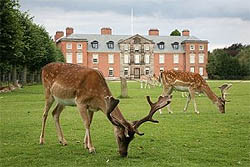 Deer at Dunham Massey
Deer at Dunham Massey Bramall Hall, Bramhall, Stockport. Large black-and-white timber-framed manor house.
Dunham Massey, Trafford. Impressive hall and deer park, managed by the National Trust. The Library contains an orrery and armillary sphere by Thomas Wright.
Hall i’ th’ Wood, Bolton. Small timber-framed manor house dating from the sixteenth century, once home to Samuel Crompton, inventor of the spinning mule. Visits by appointment.
Heaton Hall, Heaton Park. Grand example of eighteenth-century Palladian design. The grounds contain many features which were at one time or another the height of country-house fashion, including a “temple”, gatehouse lodge, and ornamental gardens. (As of February 2012, the Hall is closed to the public, although much of the Park site is accessible.)
Ordsall Hall, Ordsall, Salford. Manor house dating in part to the fifteenth century, once visited by the humanist scholar Erasmus.
Smithills Hall, Bolton. Manor house with surviving medieval features.
Wythenshawe Hall, Wythenshawe. Grand half-timbered Tudor house. (As of February 2012, the Hall is closed to the public.)
In Cheshire and Lancashire
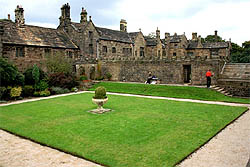 Garden at Hoghton Tower
Garden at Hoghton Tower Adlington Hall, Adlington, Cheshire. Country house developed from a Saxon hunting lodge, with gardens.
Arley Hall, Arley, Cheshire. Striking nineteenth-century interpretation of Elizabethan architecture, with extensive gardens.
Capesthorne Hall, Siddington, Cheshire. Tudor-influenced eighteenth-century home.
Dorfold Hall, Acton, Cheshire. Well-preserved Jacobean mansion house.
Gawsworth Old Hall, Gawsworth, Cheshire. Authentic black-and-white half-timbered house, largely sixteenth-century.
Gawthorpe Hall, Padiham, Lancashire. Elizabethan house with interiors by Charles Barry, managed by the National Trust. The property’s owner in the 1840s, Lady Janet Shuttleworth, married Dr James Kay, author of the influential Moral and Physical Condition of the Working-Class, founding the influential Kay-Shuttleworth family.
Hoghton Tower, Chorley, Lancashire. Distinctive castellated hilltop manor house, developed in Tudor times from a Norman fortification.
Little Moreton Hall, Congleton, Cheshire. Superb example of fifteenth- and sixteenth-century black-and-white half-timbering, famously bent and warped to crazy angles by the weight of an added third storey. Uninhabited; maintained by the National Trust, with areas left bare to demonstrate the building techniques used. Also has a moat.
Lyme Park, Disley, Cheshire. Impressive Palladian-influence hall, the largest house in Cheshire. Now in the possession of the National Trust, with rooms maintained in Edwardian period condition. Set in an extensive deer park.
Peover Hall, Over Peover, Cheshire. Redbrick manor house of Elizabethan origin, noted for its Second World War role as the headquarters of US Army General George Patton.
Rufford Old Hall, Rufford (near Ormskirk), Lancashire. National Trust-owned. The timber-framed Great Hall is fifteenth-century, but built to an older pattern, with an impressive hammerbeam roof.
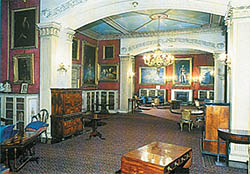 Interior, Tabley House
Interior, Tabley House Tabley House, Nether Tabley, Cheshire. Eighteenth-century Palladian redbrick and sandstone, property of the University of Manchester, now partially in use as a private nursing home, but partially open to the public with impressive displays of fine art and furniture.
Tatton Park, Knutsford, Cheshire. National Trust-owned hall, gardens, farm and parkland. Opportunities for extensive time-travel: the Old Hall, later converted to estate cottages, is Tudor; the main Hall or Mansion is eighteenth-century, with extensive collections; the nearby farm is maintained in 1930s style. Costumed guides.
Turton Tower, North Turton (near Blackburn), Lancashire. Developed from a medieval “peel tower”, built on high ground for signalling and observation, into a Tudor manor house. Owned in the seventeenth century by Humphrey Chetham, founder of the Manchester library, and in the nineteenth by the cotton-spinning magnate James Kay.
Further afield
Among the numerous historic houses and country estates which can be reached within a day’s journey, some of the more impressive and interesting include: Castle Howard, North Yorkshire; Chatsworth, Derbyshire; Hardwick Hall, Derbyshire; Harewood House, West Yorkshire; Knowsley Hall, Merseyside; Shugborough, Staffordshire.